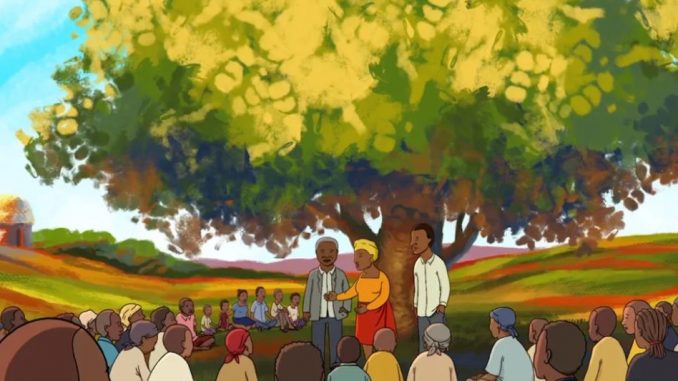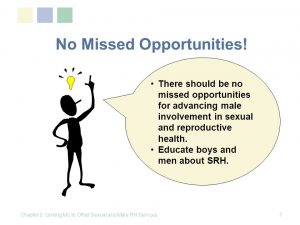
Table of Contents
Sexual and Reproductive Health:
- Sexual and Reproductive Health (SRH) is defined as a state of complete physical, mental and social well -being and not merely the absence of disease or infirmity, in all matters relating to the reproductive system and to its functions and processes.
- SRH includes several components such as approach to safe sex, family planning, desired family size, safe abortion, information and may more
- Although SRH is an issue directly related to both men and women, men are often not actively involved in the SRH promotion and other advocacy activities.
- The program itself is designed focusing more on women than in men.
- But we need to remember that men do play important role in SRH as their action determines the overall outcome.
Why are men necessary for addressing SRH problems?
1. Decision makers
- Usually male are the decision makers in the house and make every important decision regarding health education finance, etc.
- Male usually do not make decision on the favor of the women due to lack of awareness, negligence or ignorance of women’s sexual and reproductive health.
- Involvement of male in SRH would improve their understanding on women’s health and may favor the decision on their behalf.
2. Increased partner support
- Involvement of male would lead to better understanding among husband and wife or partners.
- They (men) would get to know about the pregnancy, child birth, birth intervals, maternal and neonatal health.
- This would also provide the opportunity to men to understand the effect of their decision regarding the SRH matters on the female/spouse and the entire family.
- Thus, one can support spouse to take and implement certain decision/s.
3. Increased uptake of STI and HIV services
- Inclusion of men in SRH would increase the number of people seeking STI and HIV services.
- Males generally do not participate in screening program and other health services due to stigma.
- It is necessary for men to know about transmission of STI’s and HIV and other sexual and reproductive health related diseases.
- Females seek and receive STI and HIV related services either during seeking FP services or ANC checkup but there is no such provision for male
- So, involvement of male would definitely increase the service seekers for these services.
4. Decrease the burden in women
- Involvement of men in addressing SRH problems would help in making informed decision in the family.
- The more male will understand, the more they will support.
- Involvement of male would definitely lower the burden from the female’s shoulder.
Challenges for involving male in addressing SRH problems:
a) Socio cultural challenges
- Involvement of men in SRH is often constricted due to socio cultural matters
- Gender roles are different
- Masculinity linked to man’s ability to have children
- SRH considered to be women’s arena
- This prevents male from involving in matters related to SRH or family planning
- Men too feel uncomfortable and are not open for discussion in many matters of SRH.
b) Health services and health workers attitude
- Health facilities are not father or male friendly
- Most of the health workers usually don’t appreciate the involvement of men in SRH problems and often discourage their participation.
c) Female oriented services
- All the existing services are mostly focused on the female than male.
- The role of the male is barely recognized.
- The services are also more female centric (example: family planning methods or services are more for females).
How can the role of men be strengthened in addressing SRH problems?
i) Male friendly services and programs
- The current female oriented programs need to be adjusted to involve men in all matters of SRH.
- Health professionals and health facilities needs to create the friendly environment for men and encourage their participation in solving or addressing SRH problems of both male and female.
- Male friendly clinics should be established at all facilities to address men’s sexual and reproductive health needs.
ii) Awareness programs
- Awareness programs regarding men’s sexual and reproductive health need to be conducted
- Use of mass media and social medias for the more involvement and participation of male in addressing SRH problems.

iii) Engaging boys and men throughout the life-cycle
- Men should be involved in the SRH programs in each life stage
- It is better to involve them from the young age
- Tailored information regarding the sexuality, HIV and AIDs its prevention, family planning etc., needs to be provided from the school curriculum.
- Educational programs on SRH should be integrated and updated in the existing curriculum for young people starting, at primary school level
iv) Others
- The government should give focus on SRH of male and female both.
- Strong advocacy and trainings are needed from both governmental and non-governmental sectors regarding the matter of SRH
- Capacity building of the peer educators and community leaders to work with men in their respective areas.
References and for More Information:
https://www.ncbi.nlm.nih.gov/pmc/articles/PMC3847125/
https://reproductive-health-journal.biomedcentral.com/articles/10.1186/s12978-016-0184-2
https://healthcommcapacity.org/getting-more-men-involved-in-family-planning/
https://www.unfpa.org/engaging-men-boys
https://pacific.unfpa.org/sites/default/files/pub-pdf/NZPPD_OpenHearingReport_2015.pdf
https://www.engenderhealth.org/pubs/gender/gender-toolkit/toolkit.html
https://www.rutgers.international/sites/rutgersorg/files/PDF/2016_Engaging_men_in_GBV_0.pdf
https://menandboys.ids.ac.uk/men-boys-and-gender-equality/themes/sex-health-and-rights
https://www.ncbi.nlm.nih.gov/pmc/articles/PMC4235033/
http://www.policyproject.com/pubs/countryreports/MaleInvolv_Cam.pdf
https://healthcommcapacity.org/wp-content/uploads/2017/06/Mens-SRH-Guide-final.pdf
https://www.popcouncil.org/uploads/pdfs/2015RH_StepsToIntegration8.pdf